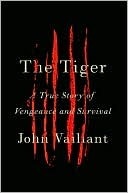More on this book
Community
Kindle Notes & Highlights
possibility of a man-eating amba like the egule might implant itself i...
This highlight has been truncated due to consecutive passage length restrictions.
Andrei Pochepnya’s death had a profound effect on the people around him, and it moved their understanding of this tiger into unfamiliar territory. Never,
Markov’s wife, along with a number of other villagers, was holding Trush personally responsible for Sobolonye’s misery. “She was pouring mud on me as if the tiger was my personal property, saying it was all my fault that it got away and that all this happened,” said Trush, recalling their first meeting. “She claimed that Markov hadn’t shot at the tiger—that the tiger had just attacked him. She was shouting so much that I wasn’t able to explain the situation to her properly. I thought she was having a mental breakdown as a result of her husband’s death, and she was blaming us for it.”
a relict
relict /ˈrelikt/ noun 1. a thing that has survived from an earlier period or in a primitive form. 2. an animal or plant that has survived while others of its group have become extinct, e.g., the coelacanth. 3. a species or community that formerly had a wider distribution but now survives in only a few localities such as refugia. [early 20th cent.: from Latin relictus ‘left behind,’ past participle of the verb relinquere.] 4. ‹archaic› a widow. [late Middle English: from Old French relicte ‘(woman) left behind,’ from late Latin relicta, from the verb relinquere.]
An oxymoron (usual plural oxymorons, more rarely oxymora) is a figure of speech that juxtaposes concepts with opposing meanings within a word or phrase that creates an ostensible self-contradiction. An oxymoron can be used as a rhetorical device to illustrate a rhetorical point or to reveal a paradox.[1][2] A more general meaning of "contradiction in terms" (not necessarily for rhetoric effect) is recorded by the OED for 1902.[3]
these six men represented close to two hundred years of hunting experience—most of it in tiger country—and yet none of them had witnessed anything quite like this. Stepping
Sheriff Gorunov traced the impressions of the attack leaps. They seemed awfully close together for such a large tiger: a sure sign, in his view, of weakness or injury. A healthy tiger could have covered that
distance in a single bound. There was no doubt this tiger was impaired, but he may have also understood from previous experience that there was no rush. It is hard to articulate how overmatched Pochepnya was, how little effort a tiger needs to make in order to subdue a human being. A tiger’s jaws can exert roughly a thousand pounds of pressure per square inch, but it takes less than a hundred pounds to crush a windpipe, and only five pounds to block the carotid artery, which causes unconsciousness almost instantly. In other words, a tiger’s fangs don’t need to puncture the skin in order to
...more
losses can be crippling and are one reason wild tigers may turn to livestock killing and man-eating. As menacing as they appear, tiger fangs are actually delicate instruments—literally, bundles of nerves and blood vessels encased in layers of bonelike dentin, sheathed in enamel and somewhat rounded at the ends. With these four surgical sensors, the tiger has the ability to feel its way through prey, differentiating between bone and tissue types to find the gap between two vertebrae in order to sever the spinal cord, or locate the windpipe in order to stifle the air supply—all at attack speed.
...more
This highlight has been truncated due to consecutive passage length restrictions.
bricolage /ˌbrēkōˈläZH, ˌbrikə-/ I. noun 1. (in art or literature) construction or creation from a diverse range of available things • the chaotic bricolage of the novel is brought together in a unifying gesture. 2. something constructed or created from a diverse range of available things • bricolages of painted junk. – origin mid 20th cent.: French, from bricoler ‘do odd jobs, repair.’


